Abstract
The role of central respiratory drive, muscle spindles and tendon organs in producing respiratory movements has been studied in the cat by recording from motoneurones supplying a set of small axial muscles inserted between each rib and the vertebra immediately rostral, the levatores costae. The levator costae muscles are active during normal inspiration but activity is progressively stronger in the muscles located in more caudal thoracic segments. Intracellular recordings from levator costae motoneurons show a characteristic central respiratory drive potential (c.r.d.p.), comprising phases of depolarization during inspiration alternating with expiratory phased hyperpolarization due to post-synaptic inhibition. Loading or unloading the levator costae muscles increases and decreases, respectively, their normal inspiratory activity. Electrophysiological and histological analysis of levator costae afferents reveals that each muscle contains three to five spindles and two to three tendon organs. By dissecting the levator costae nerve, afferent discharges from muscle spindle primary and secondary endings and those from tendon organs were recorded 'in continuity' and used to trigger an averager for analysing the synaptic potentials they evoke in levator costae motoneurones. Monosynaptic excitation and oligosynaptic inhibition originate from spindle (primary and secondary endings) and from tendon organ afferents respectively. Peculiarly a monosynaptic excitation has been evoked from a tendon organ. The action of the levator costae muscle on the respiratory movements of the ribs in the different thoracic spaces was analysed in relation to their anatomical properties and to the activity of the other respiratory muscles. The levator costae muscles, because of their relatively small size and well-defined population of proprioceptors, appear to provide a favourable preparation for studying the integrative action of the motoneurone.
Full text
PDF
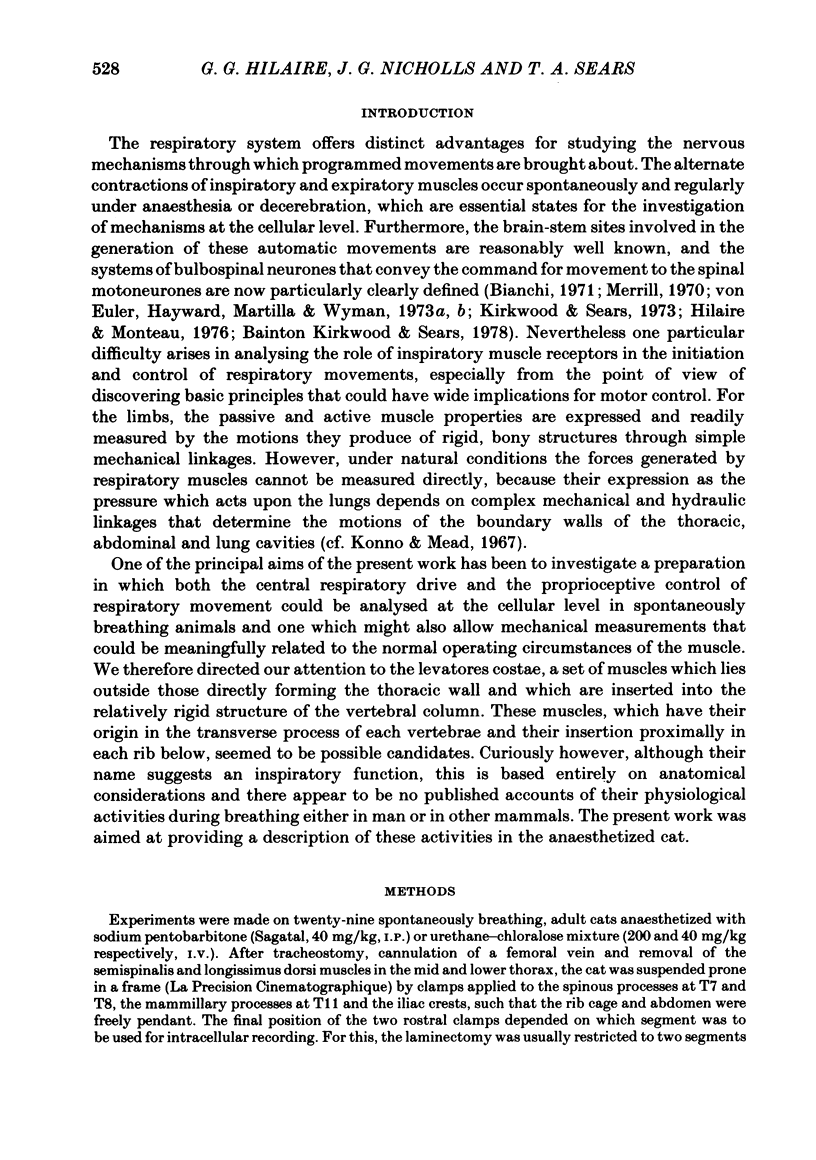

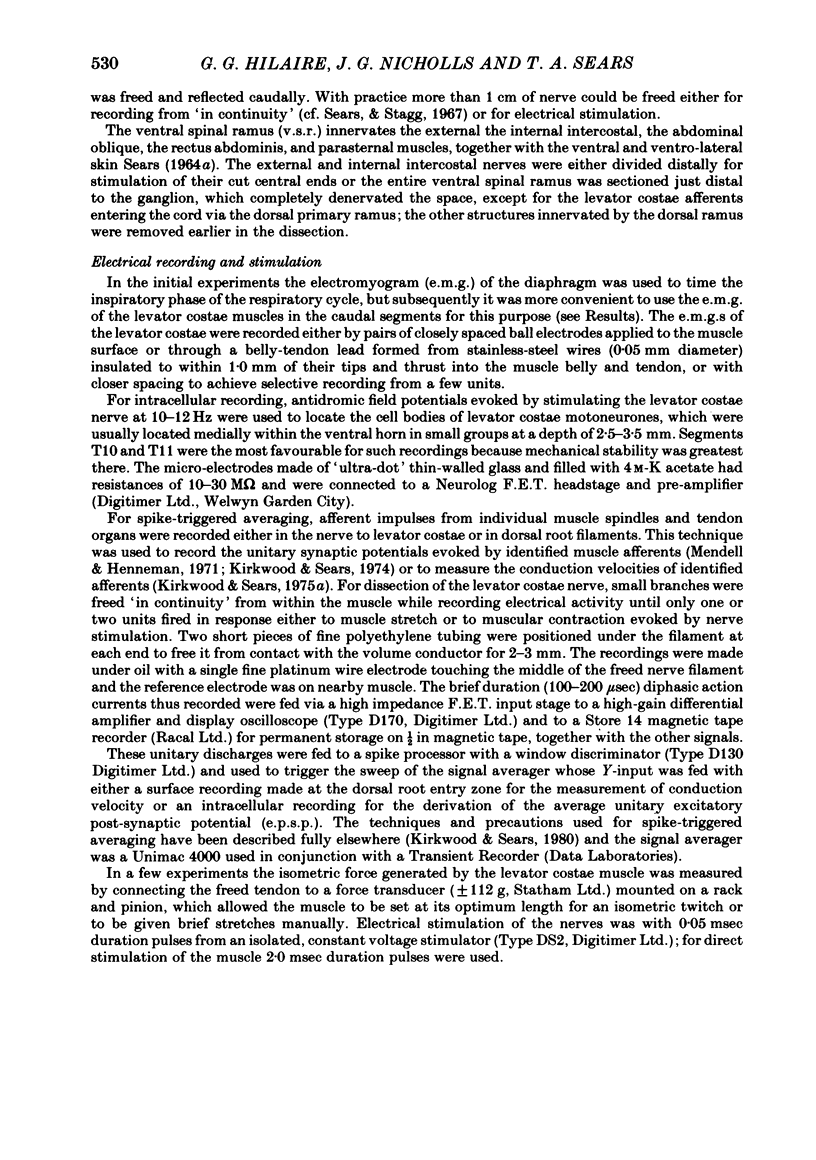
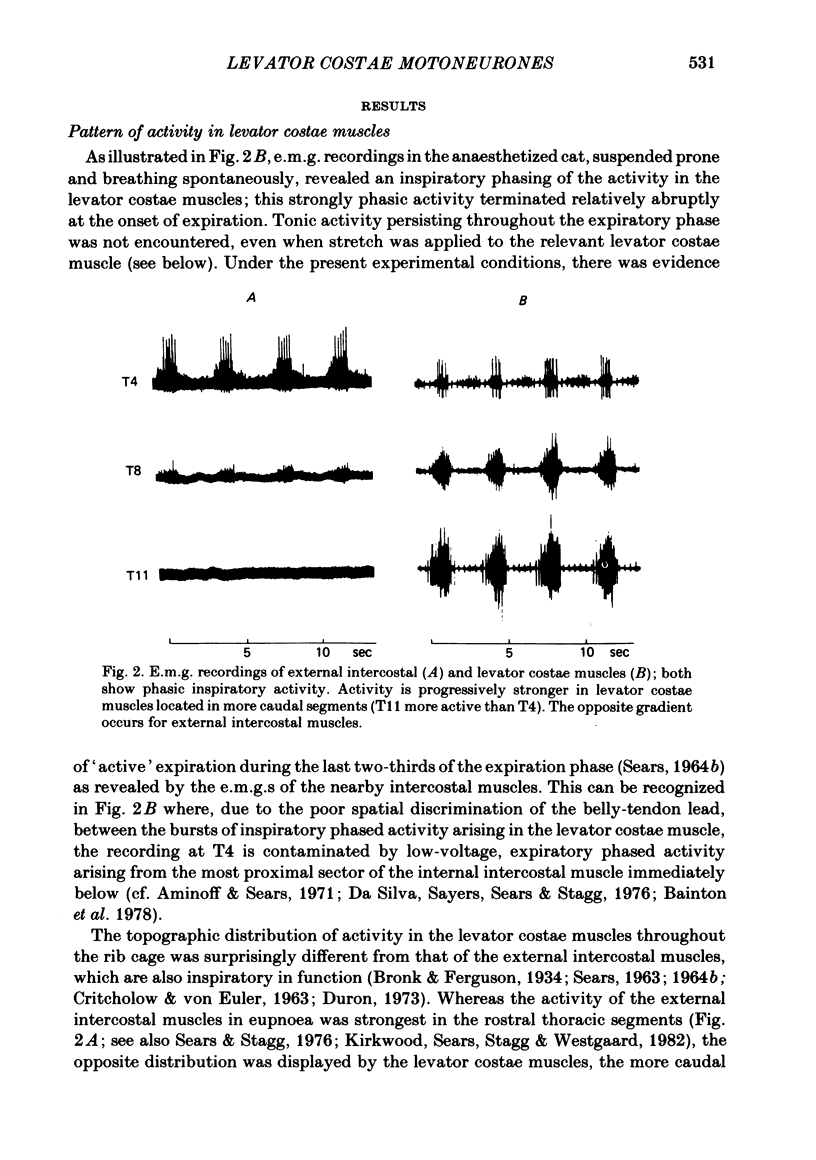


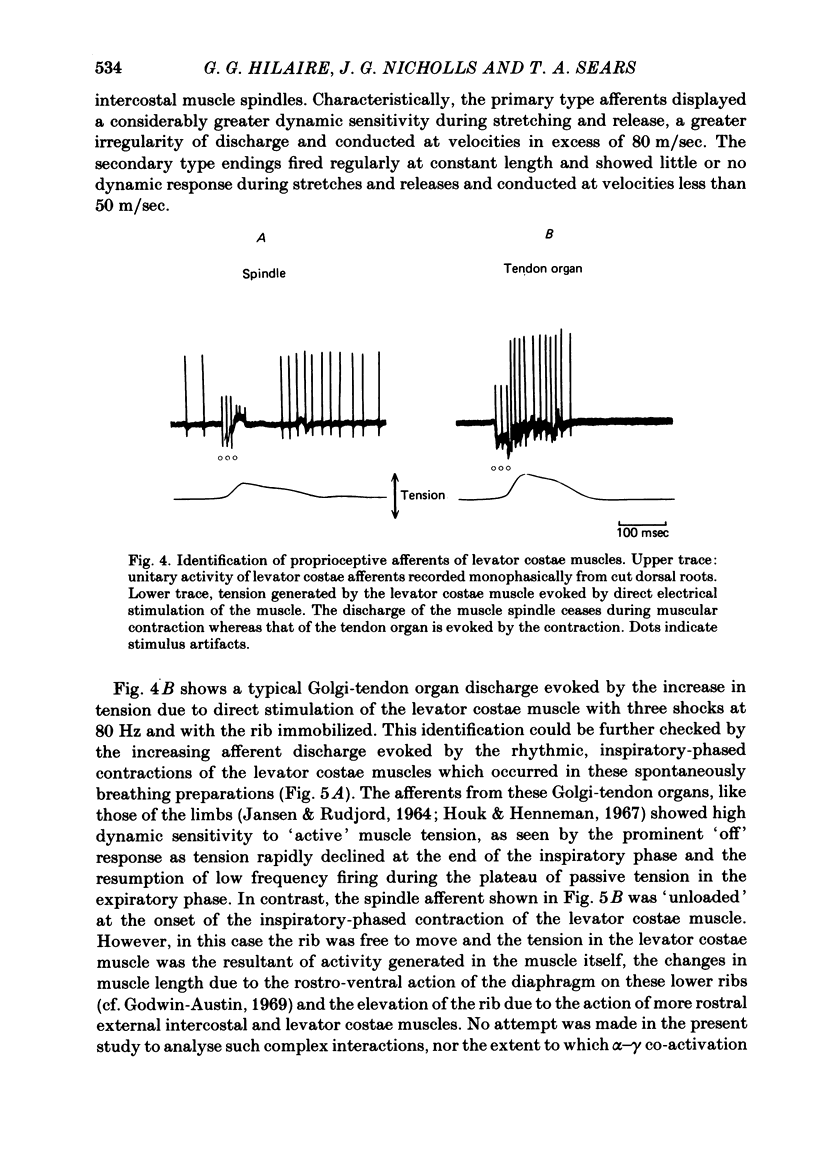
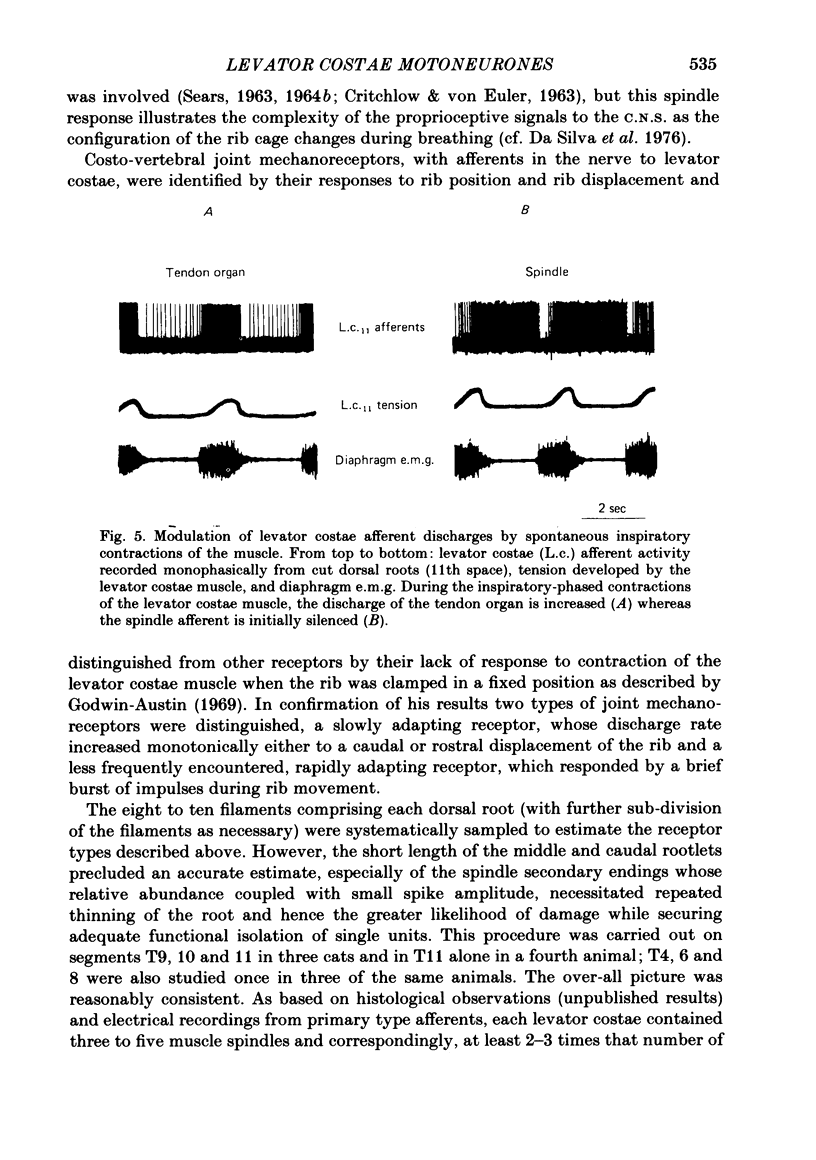
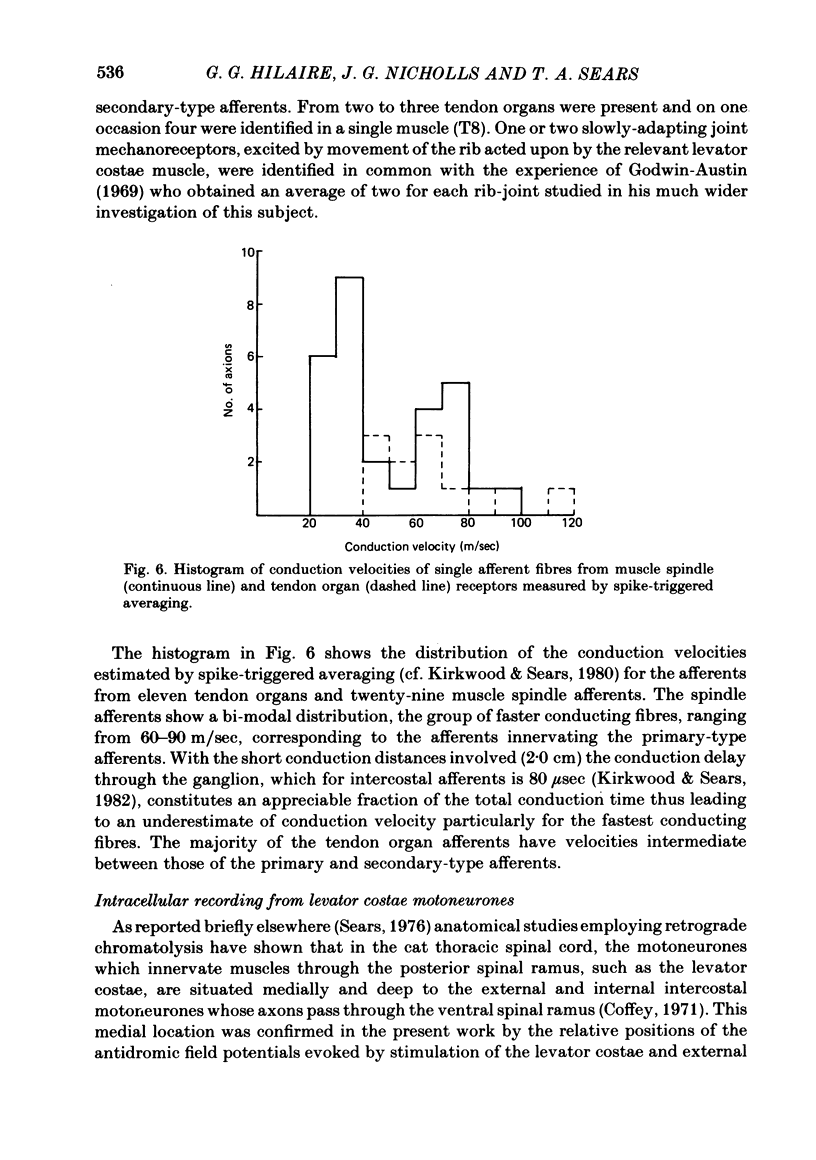

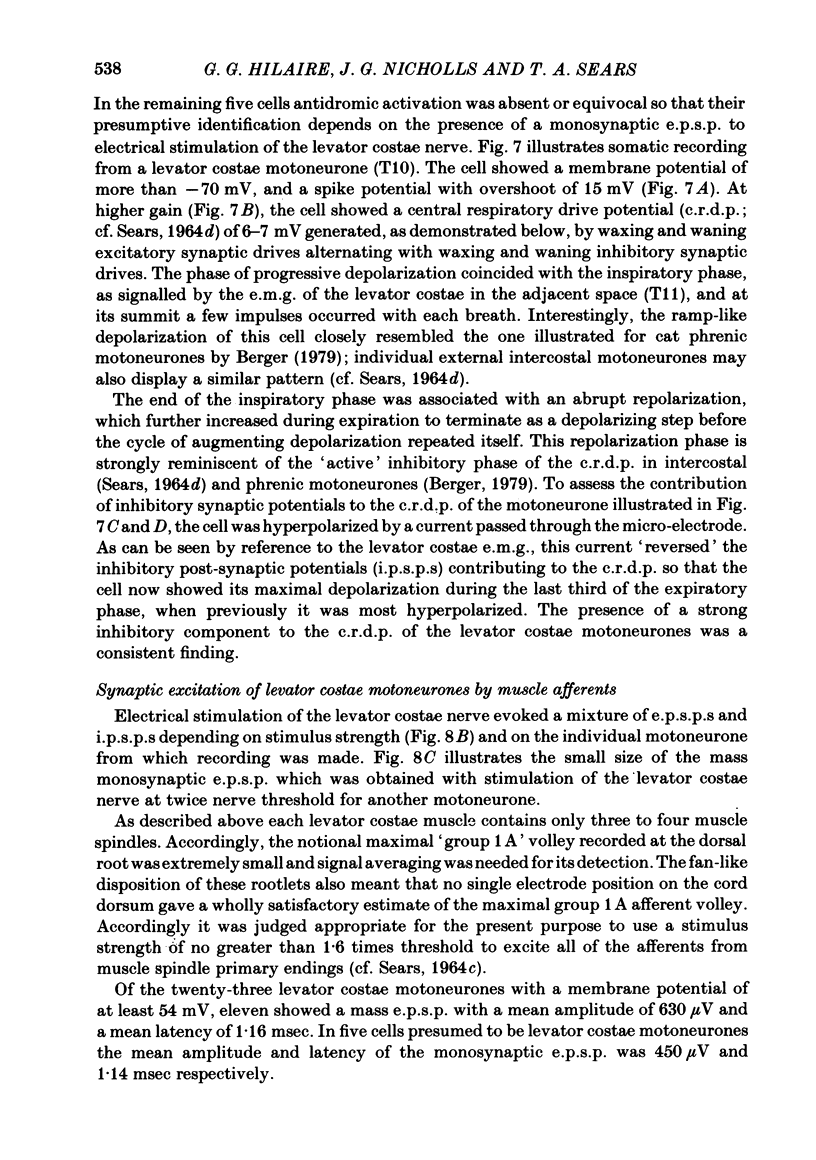

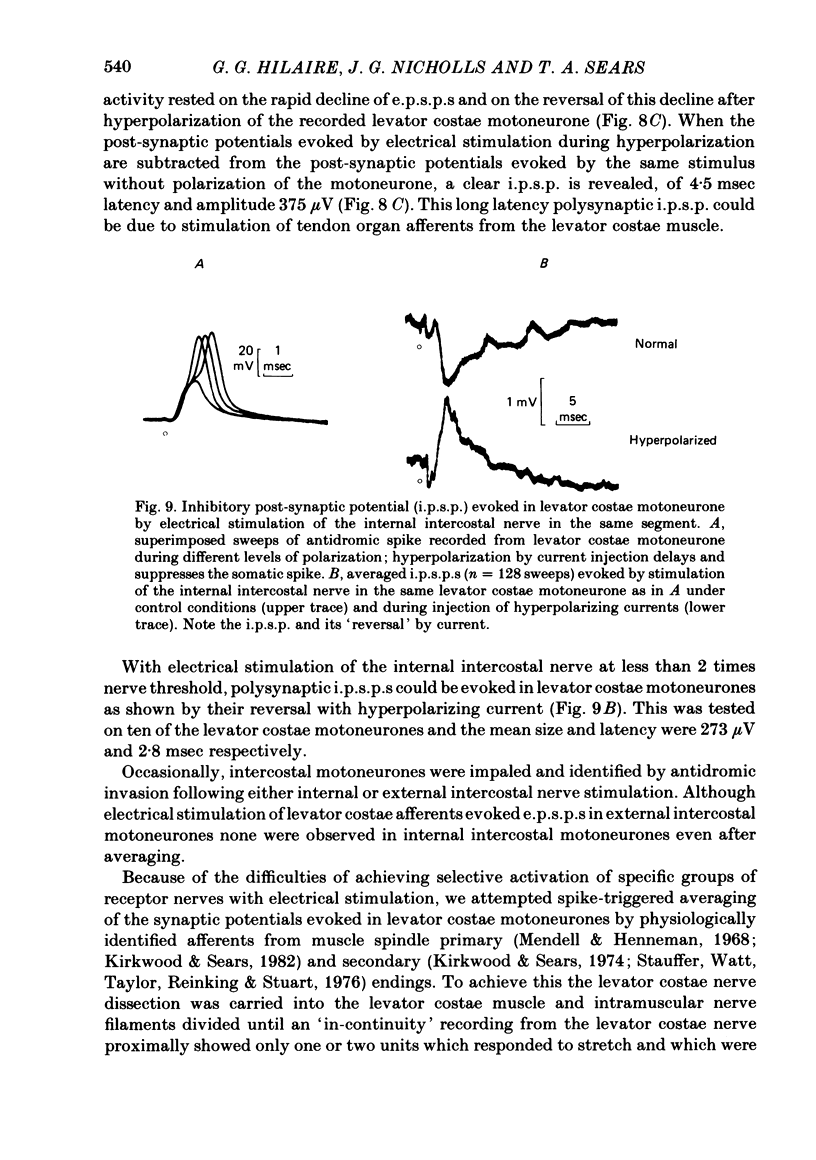


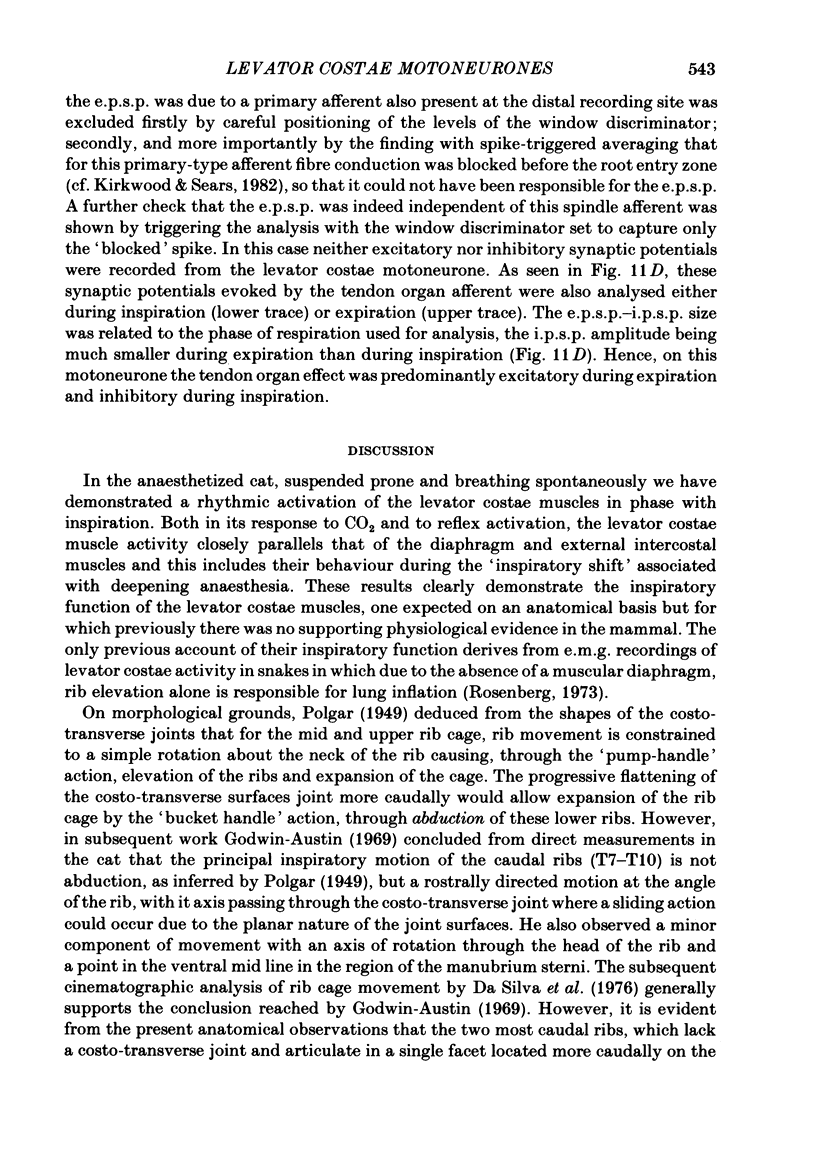


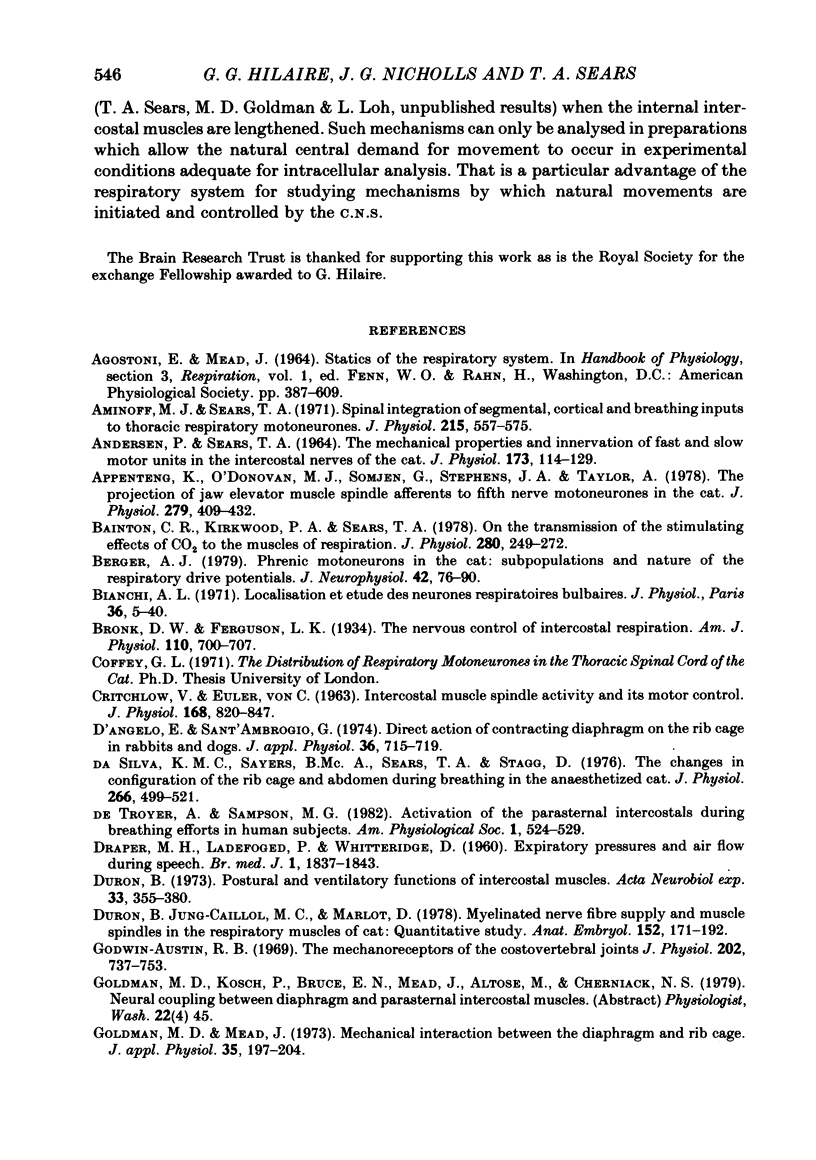


Selected References
These references are in PubMed. This may not be the complete list of references from this article.
- ANDERSEN P., SEARS T. A. THE MECHANICAL PROPERTIES AND INNERVATION OF FAST AND SLOW MOTOR UNITS IN THE INTERCOSTAL MUSCLES OF THE CAT. J Physiol. 1964 Sep;173:114–129. doi: 10.1113/jphysiol.1964.sp007446. [DOI] [PMC free article] [PubMed] [Google Scholar]
- Aminoff M. J., Sears T. A. Spinal integration of segmental, cortical and breathing inputs to thoracic respiratory motoneurones. J Physiol. 1971 Jun;215(2):557–575. doi: 10.1113/jphysiol.1971.sp009485. [DOI] [PMC free article] [PubMed] [Google Scholar]
- Appenteng K., O'Donovan M. J., Somjen G., Stephens J. A., Taylor A. The projection of jaw elevator muscle spindle afferents to fifth nerve motoneurones in the cat. J Physiol. 1978 Jun;279:409–423. doi: 10.1113/jphysiol.1978.sp012353. [DOI] [PMC free article] [PubMed] [Google Scholar]
- Bainton C. R., Kirkwood P. A., Sears T. A. On the transmission of the stimulating effects of carbon dioxide to the muscles of respiration. J Physiol. 1978 Jul;280:249–272. doi: 10.1113/jphysiol.1978.sp012383. [DOI] [PMC free article] [PubMed] [Google Scholar]
- Berger A. J. Phrenic motoneurons in the cat: subpopulations and nature of respiratory drive potentials. J Neurophysiol. 1979 Jan;42(1 Pt 1):76–90. doi: 10.1152/jn.1979.42.1.76. [DOI] [PubMed] [Google Scholar]
- Bianchi A. L. Localisation et étude des neurones respiratoires bulbaires. Mise en jeu antidromique par stimulation spinale ou vagale. J Physiol (Paris) 1971 Jan-Feb;63(1):5–40. [PubMed] [Google Scholar]
- CRITCHLOW V., VON EULER INTERCOSTAL MUSCLE SPINDLE ACTIVITY AND ITS GAMMA MOTOR CONTROL. J Physiol. 1963 Oct;168:820–847. doi: 10.1113/jphysiol.1963.sp007225. [DOI] [PMC free article] [PubMed] [Google Scholar]
- D'Angelo E., Sant'Ambrogio G. Direct action of contracting diaphragm on the rib cage in rabbits and dogs. J Appl Physiol. 1974 Jun;36(6):715–719. doi: 10.1152/jappl.1974.36.6.715. [DOI] [PubMed] [Google Scholar]
- DRAPER M. H., LADEFOGED P., WHITTERIDGE D. Expiratory pressures and air flow during speech. Br Med J. 1960 Jun 18;1(5189):1837–1843. doi: 10.1136/bmj.1.5189.1837. [DOI] [PMC free article] [PubMed] [Google Scholar]
- Da Silva K. M., Sayers B. M., Sears T. A., Stagg D. T. The changes in configuration of the rib cage and abdomen during breathing in the anaesthetized cat. J Physiol. 1977 Apr;266(2):499–521. doi: 10.1113/jphysiol.1977.sp011779. [DOI] [PMC free article] [PubMed] [Google Scholar]
- Davis J. N., Sears T. A. The proprioceptive reflex control of the intercostal muscles during their voluntary activation. J Physiol. 1970 Aug;209(3):711–738. doi: 10.1113/jphysiol.1970.sp009188. [DOI] [PMC free article] [PubMed] [Google Scholar]
- De Troyer A., Sampson M. G. Activation of the parasternal intercostals during breathing efforts in human subjects. J Appl Physiol Respir Environ Exerc Physiol. 1982 Mar;52(3):524–529. doi: 10.1152/jappl.1982.52.3.524. [DOI] [PubMed] [Google Scholar]
- Duron B., Jung-Caillol M. C., Marlot D. Myelinated nerve fiber supply and muscle spindles in the respiratory muscles of cat: quantitative study. Anat Embryol (Berl) 1978 Feb 20;152(2):171–192. doi: 10.1007/BF00315923. [DOI] [PubMed] [Google Scholar]
- Duron B. Postural and ventilatory functions of intercostal muscles. Acta Neurobiol Exp (Wars) 1973;33(1):355–380. [PubMed] [Google Scholar]
- Godwin-Austen R. B. The mechanoreceptors of the costo-vertebral joints. J Physiol. 1969 Jun;202(3):737–753. doi: 10.1113/jphysiol.1969.sp008838. [DOI] [PMC free article] [PubMed] [Google Scholar]
- Goldman M. D., Mead J. Mechanical interaction between the diaphragm and rib cage. J Appl Physiol. 1973 Aug;35(2):197–204. doi: 10.1152/jappl.1973.35.2.197. [DOI] [PubMed] [Google Scholar]
- Harrison P. J., Taylor A. Individual excitatory post-synaptic potentials due to muscle spindle Ia afferents in cat triceps surae motoneurones. J Physiol. 1981 Mar;312:455–470. doi: 10.1113/jphysiol.1981.sp013638. [DOI] [PMC free article] [PubMed] [Google Scholar]
- Hilaire G., Monteau R. Connexions entre les neurones inspiratoires bulbaires et les motoneurones phréniques et intercostaux. J Physiol (Paris) 1976;72(8):987–1000. [PubMed] [Google Scholar]
- Houk J., Henneman E. Responses of Golgi tendon organs to active contractions of the soleus muscle of the cat. J Neurophysiol. 1967 May;30(3):466–481. doi: 10.1152/jn.1967.30.3.466. [DOI] [PubMed] [Google Scholar]
- JANSEN J. K., RUDJORD T. ON THE SILENT PERIOD AND GOLGI TENDON ORGANS OF THE SOLEUS MUSCLE OF THE CAT. Acta Physiol Scand. 1964 Dec;62:364–379. doi: 10.1111/j.1748-1716.1964.tb10435.x. [DOI] [PubMed] [Google Scholar]
- Jankowska E., McCrea D., Mackel R. Pattern of 'non-reciprocal' inhibition of motoneurones by impulses in group Ia muscle spindle afferents in the cat. J Physiol. 1981 Jul;316:393–409. doi: 10.1113/jphysiol.1981.sp013796. [DOI] [PMC free article] [PubMed] [Google Scholar]
- Kirkwood P. A., Sears T. A. Excitatory post-synaptic potentials from single muscle spindle afferents in external intercostal motoneurones of the cat. J Physiol. 1982 Jan;322:287–314. doi: 10.1113/jphysiol.1982.sp014038. [DOI] [PMC free article] [PubMed] [Google Scholar]
- Kirkwood P. A., Sears T. A. Monosynaptic excitation of motoneurones from muscle spindle secondary endings of intercostal and triceps surae muscles in the cat. J Physiol. 1975 Feb;245(2):64P–66P. [PubMed] [Google Scholar]
- Kirkwood P. A., Sears T. A. Monosynaptic excitation of motoneurones from secondary endings of muscle spindles. Nature. 1974 Nov 15;252(5480):243–244. doi: 10.1038/252243a0. [DOI] [PubMed] [Google Scholar]
- Kirkwood P. A., Sears T. A. Proceedings: Monosynaptic excitation of thoracic expiratory motoneurones from lateral respiratory neurones in the medulla of the cat. J Physiol. 1973 Oct;234(2):87P–89P. [PubMed] [Google Scholar]
- Kirkwood P. A., Sears T. A. Spike triggered averaging for the measurement of single unit conduction velocities. J Physiol. 1975 Feb;245(2):58P–59P. [PubMed] [Google Scholar]
- Kirkwood P. A., Sears T. A., Stagg D., Westgaard R. H. The spatial distribution of synchronization of intercostal motoneurones in the cat. J Physiol. 1982 Jun;327:137–155. doi: 10.1113/jphysiol.1982.sp014224. [DOI] [PMC free article] [PubMed] [Google Scholar]
- Konno K., Mead J. Measurement of the separate volume changes of rib cage and abdomen during breathing. J Appl Physiol. 1967 Mar;22(3):407–422. doi: 10.1152/jappl.1967.22.3.407. [DOI] [PubMed] [Google Scholar]
- Mendell L. M., Henneman E. Terminals of single Ia fibers: distribution within a pool of 300 homonymous motor neurons. Science. 1968 Apr 5;160(3823):96–98. doi: 10.1126/science.160.3823.96. [DOI] [PubMed] [Google Scholar]
- Mendell L. M., Henneman E. Terminals of single Ia fibers: location, density, and distribution within a pool of 300 homonymous motoneurons. J Neurophysiol. 1971 Jan;34(1):171–187. doi: 10.1152/jn.1971.34.1.171. [DOI] [PubMed] [Google Scholar]
- Merrill E. G. The lateral respiratory neurones of the medulla: their associations with nucleus ambiguus, nucleus retroambigualis, the spinal accessory nucleus and the spinal cord. Brain Res. 1970 Nov 11;24(1):11–28. doi: 10.1016/0006-8993(70)90271-4. [DOI] [PubMed] [Google Scholar]
- Mortola J. P., Sant'Ambrogio G. Motion of the rib cage and the abdomen in tetraplegic patients. Clin Sci Mol Med. 1978 Jan;54(1):25–32. doi: 10.1042/cs0540025. [DOI] [PubMed] [Google Scholar]
- Munson J. B., Fleshman J. W., Sypert G. W. Properties of single-fiber spindle group II EPSPs in triceps surae motoneurons. J Neurophysiol. 1980 Oct;44(4):713–725. doi: 10.1152/jn.1980.44.4.713. [DOI] [PubMed] [Google Scholar]
- Nelson S. G., Mendell L. M. Projection of single knee flexor Ia fibers to homonymous and heteronymous motoneurons. J Neurophysiol. 1978 May;41(3):778–787. doi: 10.1152/jn.1978.41.3.778. [DOI] [PubMed] [Google Scholar]
- REYNOLDS L. B., Jr Characteristics of an inspiration-augmenting reflex in anesthetized cats. J Appl Physiol. 1962 Jul;17:683–688. doi: 10.1152/jappl.1962.17.4.683. [DOI] [PubMed] [Google Scholar]
- Rosenberg H. I. Functional anatomy of pulmonary ventilation in the garter snake, Thamnophis elegans. J Morphol. 1973 Jun;140(2):171–184. doi: 10.1002/jmor.1051400205. [DOI] [PubMed] [Google Scholar]
- SEARS T. A. Activity of fusimotor fibres innervating muscle spindles in the intercostal muscles of the cat. Nature. 1963 Mar 9;197:1013–1014. doi: 10.1038/1971013a0. [DOI] [PubMed] [Google Scholar]
- SEARS T. A. EFFERENT DISCHARGES IN ALPHA AND FUSIMOTOR FIBRES OF INTERCOSTAL NERVES OF THE CAT. J Physiol. 1964 Nov;174:295–315. doi: 10.1113/jphysiol.1964.sp007488. [DOI] [PMC free article] [PubMed] [Google Scholar]
- SEARS T. A. SOME PROPERTIES AND REFLEX CONNEXIONS OF RESPIRATORY MOTONEURONES OF THE CAT'S THORACIC SPINAL CORD. J Physiol. 1964 Dec;175:386–403. doi: 10.1113/jphysiol.1964.sp007523. [DOI] [PMC free article] [PubMed] [Google Scholar]
- SEARS T. A. THE FIBRE CALIBRE SPECTRA OF SENSORY AND MOTOR FIBRES IN THE INTERCOSTAL NERVES OF THE CAT. J Physiol. 1964 Jul;172:150–161. doi: 10.1113/jphysiol.1964.sp007409. [DOI] [PMC free article] [PubMed] [Google Scholar]
- Sears T. A., Berger A. J., Phillipson E. A. Reciprocal tonic activation of inspiratory and expiratory motoneurones by chemical drives. Nature. 1982 Oct 21;299(5885):728–730. doi: 10.1038/299728a0. [DOI] [PubMed] [Google Scholar]
- Sears T. A., Stagg D. Short-term synchronization of intercostal motoneurone activity. J Physiol. 1976 Dec;263(3):357–381. doi: 10.1113/jphysiol.1976.sp011635. [DOI] [PMC free article] [PubMed] [Google Scholar]
- Stauffer E. K., Watt D. G., Taylor A., Reinking R. M., Stuart D. G. Analysis of muscle receptor connections by spike-triggered averaging. 2. Spindle group II afferents. J Neurophysiol. 1976 Nov;39(6):1393–1402. doi: 10.1152/jn.1976.39.6.1393. [DOI] [PubMed] [Google Scholar]
- Sypert G. W., Fleshman J. W., Munson J. B. Comparison of monosynaptic actions of medial gastrocnemius group Ia and group II muscle spindle afferents on triceps surae motoneurons. J Neurophysiol. 1980 Oct;44(4):726–738. doi: 10.1152/jn.1980.44.4.726. [DOI] [PubMed] [Google Scholar]
- TAYLOR A. The contribution of the intercostal muscles to the effort of respiration in man. J Physiol. 1960 May;151:390–402. doi: 10.1113/jphysiol.1960.sp006446. [DOI] [PMC free article] [PubMed] [Google Scholar]
- Tomori Z., Widdicombe J. G. Muscular, bronchomotor and cardiovascular reflexes elicited by mechanical stimulation of the respiratory tract. J Physiol. 1969 Jan;200(1):25–49. doi: 10.1113/jphysiol.1969.sp008680. [DOI] [PMC free article] [PubMed] [Google Scholar]
- Watt D. G., Stauffer E. K., Taylor A., Reinking R. M., Stuart D. G. Analysis of muscle receptor connections by spike-triggered averaging. 1. Spindle primary and tendon organ afferents. J Neurophysiol. 1976 Nov;39(6):1375–1392. doi: 10.1152/jn.1976.39.6.1375. [DOI] [PubMed] [Google Scholar]
- von Euler C., Hayward J. N., Marttila I., Wyman R. J. Respiratory neurones of the ventrolateral nucleus of the solitary tract of cat: vagal input, spinal connections and morphological identification. Brain Res. 1973 Oct 26;61:1–22. doi: 10.1016/0006-8993(73)90512-x. [DOI] [PubMed] [Google Scholar]
- von Euler C., Hayward J. N., Marttila I., Wyman R. J. The spinal connections of the inspiratory neurones of the ventrolateral nucleus of the cat's tractus solitarius. Brain Res. 1973 Oct 26;61:23–33. doi: 10.1016/0006-8993(73)90513-1. [DOI] [PubMed] [Google Scholar]


